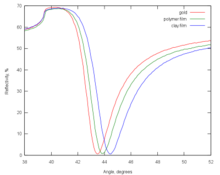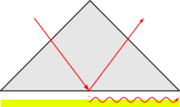Surface plasmon resonance spectroscopy

The surface plasmon resonance ( English surface plasmon resonance spectroscopy , SPR) spectroscopy is a spectroscopic analysis method that the rapid and easy quantitative determination of layer thicknesses used in the nanometer range. Surface plasmon resonance spectroscopy is used in materials science to measure the adsorption of substances and in biochemistry in the context of chip laboratory techniques.
functionality
With TM-polarized light are on a thin metal layer on the interface metal / analyte surface plasmons excited. This is done by irradiation by means of a prism in total reflection on the side facing away from the analyte. Without analyte, the intensity angle spectrum of the totally reflected light shows a minimum at a certain angle. The refractive index of the analyte sensitively influences the excitation conditions and thus the angle of the minimum.
Experimental setup
There are two different options for the arrangement: On the one hand, the Otto method, in which an air gap is left between the prism and the metal to be examined. The other is the Kretschmann method, in which a thin metal film is applied to the prism.
application
The technology is currently used intensively in drug research, as it allows the binding properties of potential new active ingredients to be examined and checked. The method is therefore typically used as an independent ( orthogonal ) secondary experiment after high throughput screening .
The Kretschmann method is also used in biochemistry, e.g. B. to determine protein-protein interactions (often used in so-called epitope mapping with antibodies) or protein-DNA interactions . Here a membrane is prepared on a prism with a gold film, which can absorb biological molecules. Covering the membrane with molecules changes the refractive index of the layer, which can be measured very sensitively with this method.
SPR spectroscopy is also used in the further development of surface coatings for medical implants. For biological inactivation, for example against endogenous proteins, there is the possibility of covering them with a streptavidin layer. The kinetics of this coating can be traced using reference materials using SPR. The advantage of this method is that the binding kinetics can be traced in real time without influencing the analytes.
See also
literature
- Rudolf W. Kessler: Process Analytics: Strategies and Case Studies from Industrial Practice . Wiley-VCH, 2006, ISBN 978-3-527-31196-5 , pp. 178–179 ( limited preview in Google Book search).
- RBM Schasfoort, AJ Tudos: Handbook of surface plasmon resonance. Royal Society of Chemistry, Cambridge 2008, ISBN 978-0-85404-267-8 ( limited preview in Google book search).
Individual evidence
- ↑ X. Guo: Surface plasmon resonance based biosensor technique: a review. In: Journal of biophotonics. Volume 5, Number 7, July 2012, ISSN 1864-0648 , pp. 483-501, doi: 10.1002 / jbio.201200015 , PMID 22467335 .
- ^ S. Roh, T. Chung, B. Lee: Overview of the characteristics of micro- and nano-structured surface plasmon resonance sensors. In: Sensors , Volume 11, Number 2, 2011, pp. 1565–1588, doi: 10.3390 / s110201565 , PMID 22319369 , PMC 3274020 (free full text).
- ↑ CJ Fee: Label-free, real-time interaction and adsorption analysis 1: surface plasmon resonance. In: Methods in molecular biology , Volume 996, 2013, pp. 287-312, doi : 10.1007 / 978-1-62703-354-1_17 , PMID 23504431 .
- ↑ A. Otto: Excitation of nonradiative surface plasma waves in silver by the method of frustrated total reflection. In: Journal of Physics. Volume 216, 1968, pp. 398-410, doi: 10.1007 / BF01391532 .
- ↑ E. Kretschmann: The determination of optical constants of metals by excitation of surface plasma oscillations. In: Zeitschrift für Physik , Volume 241, 1971, pp. 313-324, doi: 10.1007 / BF01395428 .
- ↑ SG Patching: Surface plasmon resonance spectroscopy for characterization of membrane protein-ligand interactions and its potential for drug discovery. In: Biochimica et Biophysica Acta . Volume 1838, number 1 Pt A, January 2014, pp. 43-55, doi: 10.1016 / j.bbamem.2013.04.028 , PMID 23665295 .
- ↑ P. Säfsten: Epitope mapping by surface plasmon resonance. In: Methods Mol Biol. , Volume 524, 2009, pp. 67-76. doi : 10.1007 / 978-1-59745-450-6_5 , PMID 19377937 .
- ↑ H. Sípová, J. Homola: Surface plasmon resonance sensing of nucleic acids: a review. In: Analytica chimica acta. Volume 773, April 2013, ISSN 1873-4324 , pp. 9-23, doi: 10.1016 / j.aca.2012.12.040 , PMID 23561902 .
- ↑ M. Lehnert, M. Gorbahn, M. Klein, B. Al-Nawas, I. Köper, W. Knoll, M. Veith: Streptavidin-coated TiO 2 surfaces are biologically inert: Protein adsorption and osteoblast adhesion studies . In: Journal of Biomedical Materials Research Part A . 100A, no. 2 , February 1, 2012, p. 388-395 , doi : 10.1002 / jbm.a.33281 .

